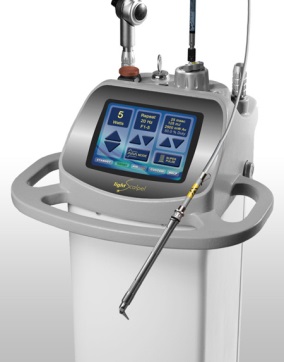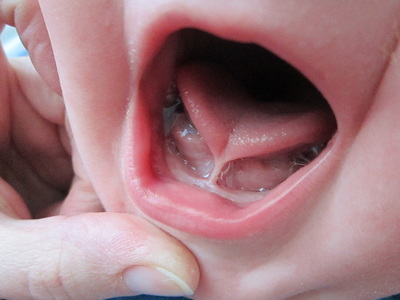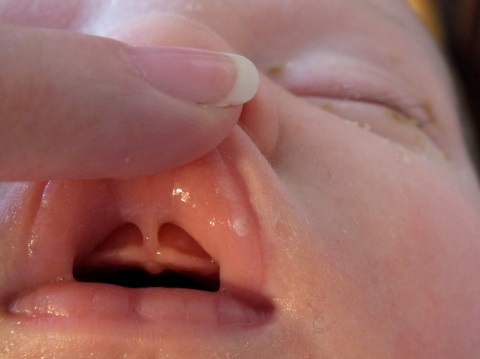






There are many ways to revise a tongue-tie and a lip-tie, including cautery, scissors and scalpel, but the safest, least invasive and most effective treatment is the using a laser.
We are the ONLY practice in West Chester, PA that offers laser treatment of infant tongue-tie and lip-tie revision using the LightScalpel CO2 laser. The advantages include:
Treatment is simple. The newborn is wrapped in a blanket or similar appliance to control unwanted movements and then the frenum is released. The procedure requires no needles, but some topical anesthetic (a little numbing) may be utilized followed by a revision with the laser. Post-operative discomfort is usually minimal. In most cases, Tylenol or a similar discomfort relieving medication is rarely required.
After the treatment is completed, children can immediately begin nursing and the mothers' have reported immediate relief of pain, extended nursing and improved infant sleeping. However, some infants may take a day or two to, possibly up to a week or more to nurse properly. Post-operative follow-up with a lactation consultant is recommended and may be necessary. Most important is active wound management (stretching) that is vital to prevent reattachment.

The LightScalpel CO2 laser is a device that produces a concentrated beam of light. The highly focused CO2 laser beam vaporizes cleanly and precisely while sealing blood vessels at the same time. Our laser is so precise that, if needed, we can selectively remove only a few cells at a time.
When parents meet us for the first time to discuss their child's tongue or lip-tie, the first question they ask is "Why has no one ever mentioned this to me before?" This is usually followed by a second and third question, "Is the procedure really necessary?" and "What will happen if we do not do it?" To answer all these questions, a complete oral examination is always required so that we can discuss all the clinical and, when appropriate, x-ray findings.
Diagnosis and Rationale for Treatment of Tongue-Tie

A common myth that is often repeated is that "the frenum will stretch and that we do not need to treat this condition." The reality is that a tongue-tie, by interfering with normal tongue mobility, can exert a harmful effect on many aspects of life. Ankyloglossia is a relatively common finding in the newborn population (approximately 3%) and represents a significant proportion of breastfeeding problems. Sadly, it is one of the most misdiagnosed and overlooked congenital abnormality observed in children today. The Academy of Breastfeeding Medicine suggests the following be used when evaluating whether a newborn requires a revision of the frenum: Un-sustained latch, Creased, blanched or bleeding nipples after feeding, Prolonged feeds, Mom in severe pain with latch, Unsatisfied infant after prolonged feeds, Incomplete breast drainage, Infant falls asleep on the breast, Gumming or chewing on the nipple, Infected nipples, Plugged ducts, Poor weight gain or failure to thrive, and Inability to hold pacifier.

While tongue-tie is the most common cause of nursing difficulties the maxillary labial frenum can also contribute to latch problems. When you look at this tissue, it actually is an attachment of the upper lip directly to the oral mucosa. When it is attached very tightly and into the area where the teeth will eventually erupt or into the small area known as the anterior papilla, it may also be a contributing factor in preventing a breastfeeding infant from developing a good latch while trying to flare his or her lips widely during breastfeeding. Future problems that may also develop and which the maxillary labial frenum may be a contributing factor includes: dental decay on the upper front teeth, gaps (diastemas) between the two front teeth, orthodontic or periodontal problems later in the child's oral development, poor lip mobility or function, especially during smiling and speaking. The maxillary (upper lip) frenum restrictions may occur by themselves or in conjunction with tongue-ties and can easily be revised without the need for the operating room or general anesthesia.
Nursing properly not only affects good nutrition, but it affects the development of the entire facial musculature. Babies who are tongue tied may have sleep apnea, which studies are now showing may cause hyperactivity in children. In addition, many babies are diagnosed with acid reflux and put on medication, when they may only need to release the tongue and the lip so the mother has a deep latch. So if your infant is doing a lot of latching and clicking, it will cause aerophagia, which causes your baby to suck air into his belly. This causes the crankiness, regurgitation and discomfort for the baby. Medication won’t correct this.
There are many ways to revise a tongue-tie and a lip-tie, including cautery, scissors and scalpel, but the safest, least invasive and most effective treatment is the using a laser. We are the ONLY practice in West Chester, PA that offers the Lightscalpel CO2 laser for treatment of infant tongue-tie and lip-tie revision, and here are the benefits: Excellent hemostasis (risk of bleeding significantly reduced), Bactericidal (little chance of any type of infection), Quick (time to complete procedure is seconds, not minutes), and NO need to place infant into the OR or need for sedation! Treatment is relatively simple. The newborn is wrapped in a blanket or similar appliance to control unwanted movements and then the frenum is released. The procedure requires no needles, but some topical anesthetic (a little numbing) may be utilized followed by a revision with the laser. Post-operative discomfort is usually limited to a few hours after the numbing has disappeared. In most cases, Tylenol or a similar discomfort relieving medication is all that is required. The laser is a much kinder method of revision, unlike electrosurgery, which is actually a burn, and the scalpel which cuts deeper than needed. There is little damage to adjacent tissue when using the laser, therefore healing is quicker and less post-operative discomfort occurs. In reality, the procedure is simpler than a filling!
After the treatment is completed, children can immediately begin nursing and the mothers' have reported immediate relief of pain, extended nursing and improved infant sleeping. However, some infants may take a day or two to up to a week or more to nurse properly. Post-operative follow-up with a lactation consultant is recommended and may be necessary. Most important is active wound management (stretching) that is vital to prevent reattachment.
Our goal is to help every patient experience the benefits of good oral health and a beautiful smile. We value the trust you have placed in our office and strive to provide solutions that meet your dental needs and expectations of care.
